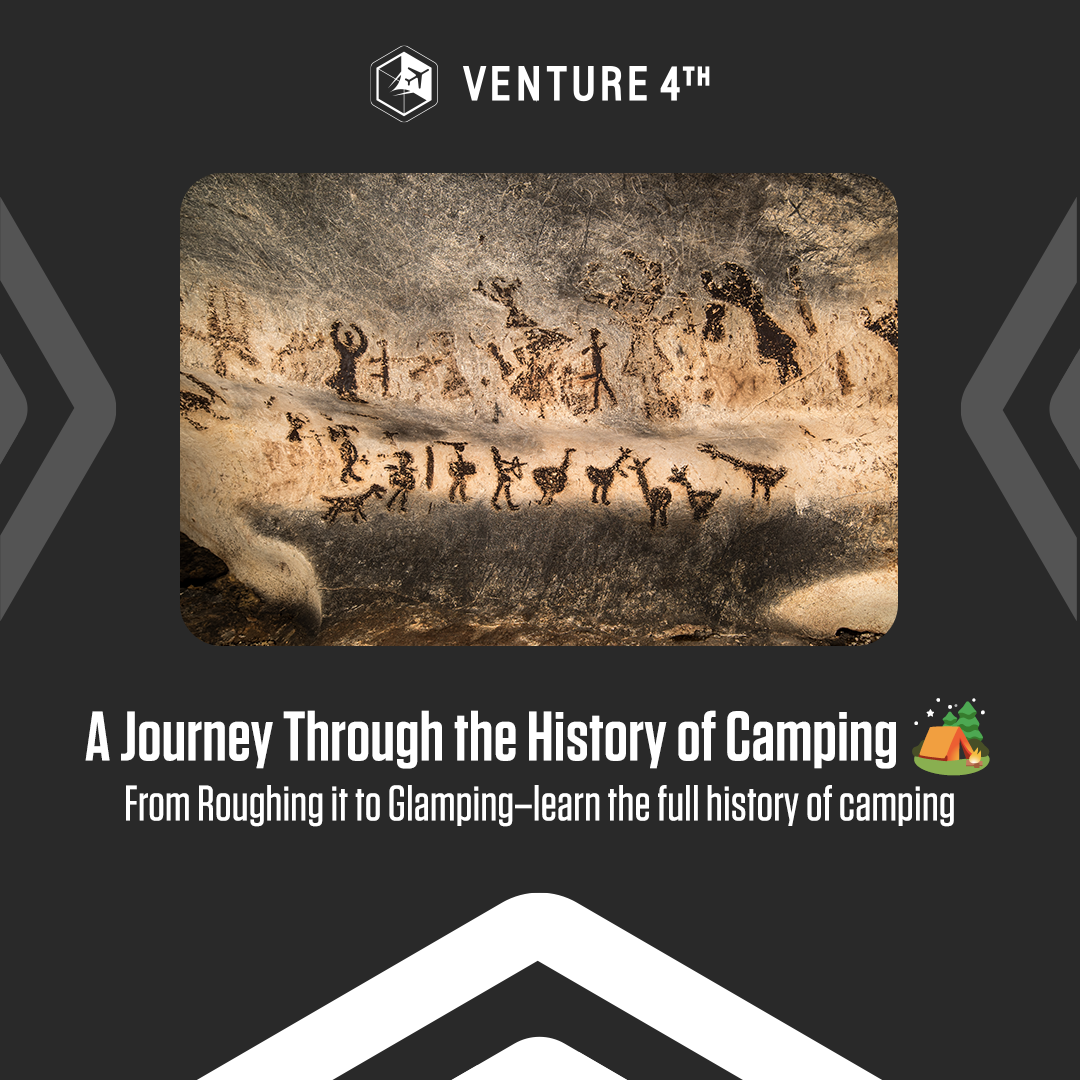In this blog, let us take you through the history of camping. From prehistoric times to the newest trend of glamping, we will cover millennia. Buckle up, my adventurous friend, as we embark on a journey through time and tents.
The Origins of Camping
Early Humans and the Nomadic Lifestyle
Our ancestors may not have been setting up tents and roasting marshmallows, but they were the OG campers. Moving from place to place, following game and foraging for food, they camped out of necessity. Their “campgrounds” were caves or basic huts made of animal hides and bones.
You could say that this nomadic lifestyle was camping at its most elemental: no frills, just survival.
Camping in Ancient Civilizations
If early humans were the pioneers of the camping world, then the Roman Legions were the first to add a touch of military precision to it. Imagine vast fields organized into grid-like formations of Roman camps, known as “castra.”
Now, the Roman Legions were on serious business—conquering lands and expanding one of history’s greatest empires. But even then, their approach to camping was methodical and quite innovative.
Unlike the nomadic tribes that set up camp wherever nature’s bounty was most promising, the Roman Legions followed specific blueprints. Each castra was a marvel of military engineering with defensive walls, ditches, and towers. The camps were typically square or rectangular and divided into sections, each with a designated purpose. You’d find areas for command tents, barracks, kitchens, and even makeshift hospitals.
These semi-permanent fortifications sometimes evolved into permanent settlements, some of which grew into the towns and cities we know today. For example, many European cities with names ending in “-chester” or “-caster” (like Manchester or Lancaster) trace their origins back to Roman castra!
Native Americans and Traditional Camping
While Roman legions were setting up fortifications in a highly organized manner, across the ocean, Native Americans were also perfecting their own form of camping. Their approach was different but no less ingenious. Tailored to their unique environments and needs, Native American structures like tipis, wigwams, and longhouses were marvels of pre-modern engineering.
Native Americans across various regions crafted ingenious dwellings tailored to their specific environments and lifestyles, all while keeping sustainability in mind. The Plains tribes, for example, lived in tipis that could be quickly assembled and disassembled, crucial for their nomadic life following buffalo herds. These tipis were aerodynamically designed to withstand strong winds and featured smoke flaps at the top for ventilation. Meanwhile, in the Northeast and the Great Lakes region, tribes built wigwams with frames made from young, flexible trees and covered with woven mats or bark. These semi-permanent structures could be adapted in shape to fit the needs of different tribes. The Iroquois took it a step further with longhouses, and communal timber dwellings that could house multiple families and span up to 200 feet.
What unites these diverse structures is the profound understanding Native Americans had of their environment. They used local, sustainable materials and designed their homes to meet the unique challenges posed by their geographical settings. Whether it was the aerodynamic tipis of the Plains or the insulated wigwams of the Northeast, each was a masterpiece of pre-modern engineering. Their approach to camping and dwelling was not just functional but deeply rooted in a philosophy of sustainability and respect for the land—lessons that modern campers can still learn from today.
Camping as Recreation
19th Century: The Birth of Recreational Camping
The 19th century marked a major pivot in the history of camping. Until this point, camping was primarily a means of survival or a military strategy. But as the Industrial Revolution reconfigured society, introducing factories and urbanization, people began to feel the need to escape the crowded, polluted cities and reconnect with nature. Camping started to be seen not just as a necessity, but as recreation—a way to find solace, rejuvenation, and a return to the “simpler life.”
Enter Ralph Waldo Emerson and Henry David Thoreau, two American transcendentalists who played pivotal roles in shifting public perception about nature and wilderness.
Ralph Waldo Emerson
Emerson was a philosopher, essayist, and lecturer who became one of the leading voices advocating for the inherent goodness of people and nature. He urged individuals to trust their intuition over religious doctrines or societal norms. His work “Nature,” published in 1836, argued for the sublime beauty and spiritual value of the natural world. For Emerson, nature was not just a backdrop for human activity but a living force to engage with intellectually and emotionally. Nature was to be revered, and by immersing oneself in it, one could find deeper truths and greater insights into life’s bigger questions.
Henry David Thoreau
Thoreau, a disciple of Emerson, took these ideas a step further. In his famous experiment at Walden Pond, Thoreau put Emerson’s philosophies into practice. For two years, two months, and two days, he lived in a cabin he built himself, with the aim of living a simple, self-reliant life amidst nature. His book “Walden,” which documented this experience, became a seminal work advocating for individualism, self-reliance, and the profound, renewing powers of nature. Thoreau viewed his time in the woods as an opportunity to escape the materialism and distractions of society to focus on the essentials of life.
Both Emerson and Thoreau helped set the cultural stage for the embrace of recreational camping. They proposed that the act of retreating into nature could serve as a counterbalance to industrialized life, offering spiritual, psychological, and physical benefits. Their philosophies encouraged people to see nature as a sanctuary, a place to rediscover oneself, and it’s this view that has significantly influenced how we approach camping today. Nature became not just a location, but a destination for renewal, shaping the way we camp for generations to come.
Thomas Hiram Holding and the Camping and Caravanning Club: Institutionalizing Leisure Camping
Just as Emerson and Thoreau shaped the American consciousness about the philosophical merits of spending time in nature, Thomas Hiram Holding had a parallel impact on the practical aspects of camping in the United Kingdom. Known as the “patron saint of camping,” Holding was instrumental in taking camping from the realm of necessity or individual recreation and turning it into an organized, communal activity.
In 1901, Holding founded the Camping and Caravanning Club, which sought to organize and promote camping as a healthy and affordable way to spend leisure time. The club not only provided a platform for camping enthusiasts to connect but also set standards, offered advice, and even scouted and recommended camping locations. This brought a level of organization and legitimacy to camping, making it accessible to the average person who might not have the skills or confidence to venture out into the wilderness alone.
Under Holding’s influence, camping became not just an activity but a culture, with its own set of guidelines, social norms, and communal gatherings. It wasn’t just about escaping urban life; it was also about community, camaraderie, and sharing experiences and knowledge. Camping morphed from a solitary or familial activity into a communal one, complete with clubs, publications, and even special camping sites endorsed by the organization.
And just when things were starting to modernize, we’ll take a little break.
That’s right! This is a two-parter and in the second part, we will cover modern trends, glamping, and the future of camping.




